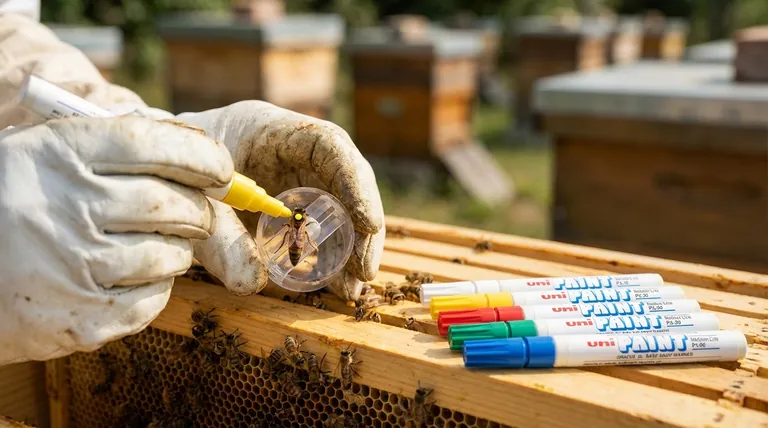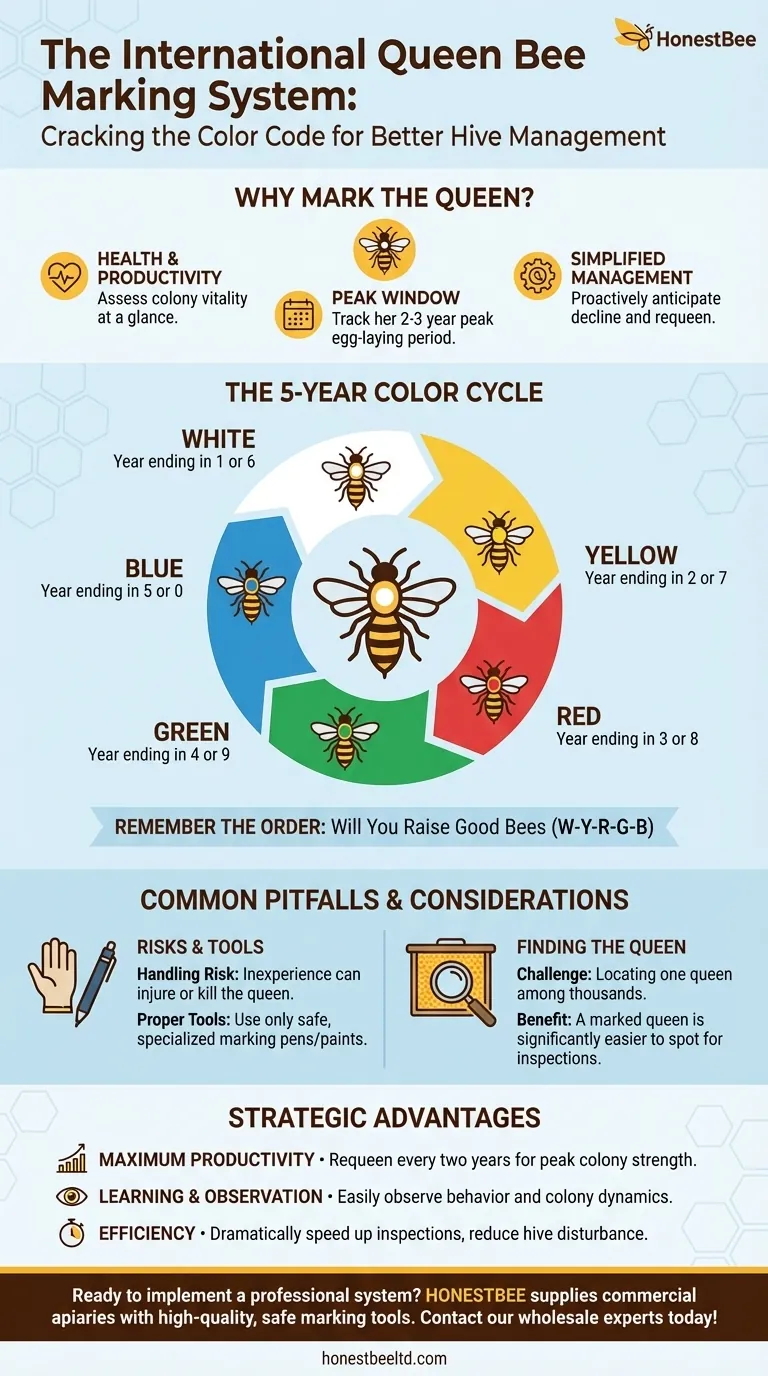The international queen bee marking system is a five-color code used by beekeepers to track the age of their queen. The color corresponds to the last digit of the year she was born or introduced to the hive, following a repeating five-year cycle: White (1 or 6), Yellow (2 or 7), Red (3 or 8), Green (4 or 9), and Blue (5 or 0).
At its core, this color-coding system isn't just for identification; it's a critical management tool that allows a beekeeper to assess a colony's health and productivity at a glance by knowing the exact age of its queen.

Why a Queen's Age is Critical
The Heart of the Colony
A honeybee colony's success—its population, temperament, and honey production—is directly tied to the vitality of its queen. She is the sole egg-layer, responsible for producing every new bee in the hive.
The Peak Productivity Window
While a queen can live for up to five years, her peak egg-laying performance typically occurs in her first two to three years. After this period, her laying rate often declines, which can lead to a smaller, less productive, and more vulnerable colony.
Simplifying Hive Management
Knowing the queen's age allows a beekeeper to anticipate this decline. It provides a clear, data-driven basis for deciding when to requeen—the process of replacing an aging queen with a young, vigorous one to maintain colony strength.
The Color System Explained
The Five-Year Cycle
The system uses five colors that rotate in a fixed sequence. This cycle ensures you will never have two queens of different ages with the same color in a hive, as queens rarely live a full five years.
The standard colors are:
- White: for years ending in 1 or 6
- Yellow: for years ending in 2 or 7
- Red: for years ending in 3 or 8
- Green: for years ending in 4 or 9
- Blue: for years ending in 5 or 0
A Simple Mnemonic
To remember the order, beekeepers use a simple mnemonic: Will You Raise Good Bees.
This phrase directly maps to the color sequence: White, Yellow, Red, Green, Blue, corresponding to years ending in 1/6, 2/7, 3/8, 4/9, and 5/0 respectively.
Common Pitfalls and Considerations
The Risk of the Mark
Marking a queen requires catching and handling her, which carries a small but real risk. An inexperienced beekeeper can accidentally injure or kill her, which would be a major setback for the colony.
Proper Tools are Essential
Specialized queen-marking pens or paints are used for this task. Using the wrong type of paint could be toxic to the queen or wear off too quickly, defeating the purpose of the mark.
Finding the Queen
The most challenging part of the process is often locating the single queen among tens of thousands of other bees. A marked queen is significantly easier to find during subsequent hive inspections, saving valuable time and reducing disturbance to the colony.
Making the Right Choice for Your Goal
- If your primary focus is maximum productivity: Use the color code to proactively requeen your hives every two years, ensuring your colonies are always led by a queen in her prime.
- If your primary focus is learning and observation: Marking the queen makes her easy to spot, allowing you to observe her behavior and better understand the colony's internal dynamics.
- If your primary focus is efficiency: A marked queen can be located in seconds instead of minutes, dramatically speeding up hive inspections and reducing stress on the bees.
Ultimately, marking your queen is a fundamental practice of modern beekeeping that transforms hive management from guesswork into a well-informed strategy.
Summary Table:
| Color | Corresponding Year Ending In |
|---|---|
| White | 1 or 6 |
| Yellow | 2 or 7 |
| Red | 3 or 8 |
| Green | 4 or 9 |
| Blue | 5 or 0 |
Ready to implement a professional queen-marking system in your apiary? HONESTBEE supplies commercial apiaries and beekeeping equipment distributors with the high-quality, safe marking pens and tools needed for efficient hive management. Ensure your colonies are led by productive queens—contact our wholesale experts today to discuss your supply needs!
Visual Guide

Related Products
- Queen Bee Marking Pen UNI Medium Point for Queen and Bee Marking
- Queen Bee Marking Pen POSCA Queen Marking Pens for Beekeeping Bee Markers
- Jenter Queen Rearing Kit Complete Set for Bee Breeding
- Nicot Queen Rearing Kit for Beekeeping and Grafting in Nicot System
- No Grafting Queen Rearing Kit: System for Royal Jelly Production and Queen Rearing
People Also Ask
- What are the benefits of marking queen bees? Boost Hive Health & Management Efficiency
- What type of pen is used to mark a queen bee? A Guide to Safe, Effective Hive Management
- What is the purpose of a queen marking pen in beekeeping? Essential for Efficient Hive Management
- What type of markers are commonly used for marking Queen bees? Choose the Safe, Non-Toxic Standard
- Why is marking a Queen bee important for beekeepers? Elevate Your Apiary Management



















